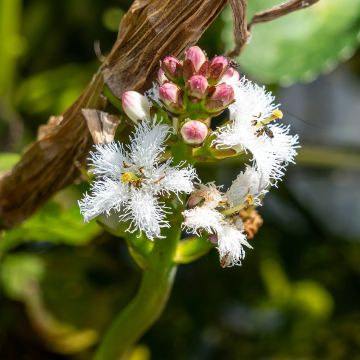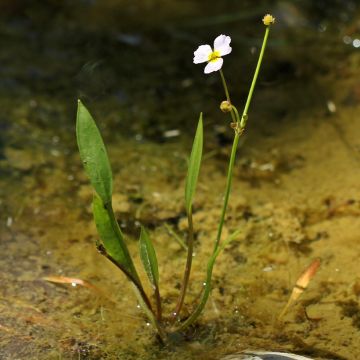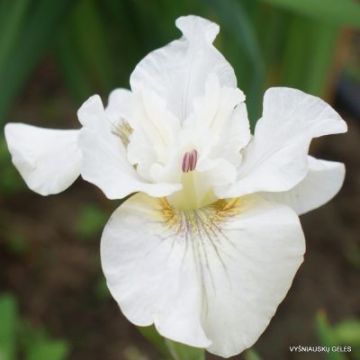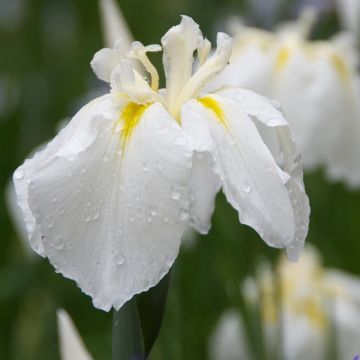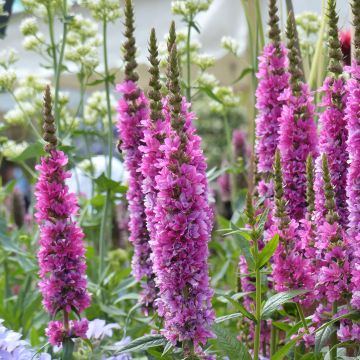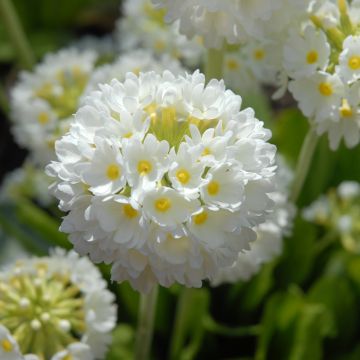

Nymphaea Pygmaea Alba - Water Lily
Nymphaea Pygmaea Alba - Water Lily
Nymphaea Pygmaea Alba
Water Lily
Why not try an alternative variety in stock?
View all →This plant carries a 12 months recovery warranty
More information
We guarantee the quality of our plants for a full growing cycle, and will replace at our expense any plant that fails to recover under normal climatic and planting conditions.
From €5.90 for pickup delivery and €6.90 for home delivery
Express home delivery from €8.90.
Does this plant fit my garden?
Set up your Plantfit profile →
Description
The French hybrid (1929) Nymphaea Colonel A.J Welch is a hardy, very vigorous water lily suitable for medium to large, deep ponds (up to 1.5m (5ft)). Between June and September, its flowers open in a cup shape and then bloom into a star shape (up to 15cm (6in) in diameter with approximately 23 petals). They are light yellow harmonizing with the golden yellow stamens. Its many dark green leaves are marbled with bronze and marked with brownish-purple when young.
Nymphea 'Colonel A.J. Welch' is a deciduous aquatic perennial with rhizomes belonging to the Nymphaeaceae family. It is a hardy hybrid obtained through cross-breeding various European and North American species, including Nymphaea alba, Nymphaea odorata, and Nymphaea mexicana. It develops large floating, deeply heart-shaped, entire, wavy-edged or toothed leaves, some of which stand erect. The plant will reach 20cm (8in) high, flowering fairly well from June until autumn and spreading at least 150cm (59in). The large, perfectly shaped, very double flowers 18cm (7in) in diameter are solitary, floating, open during the day and closed at night. They are a very bright pale yellow with golden yellow stamens. The flowers are followed by fruits containing numerous seeds. The fruit ripens underwater and releases floating seeds, which will eventually sink and germinate in the mud.
Choose easy, well-flowered varieties, the right size for your pond. Water Lilies will be the main attraction of your pond with their spectacular flowers. Most of them bloom from spring until early autumn. Water lilies are essential for maintaining the balance of a garden pond as they contribute to water oxygenation and their leaves will provide shade and shelter for your fish, which in turn protect the lilies from predatory insects such as aphids.
The genus name comes from the Greek "nymphaia" and the Latin "nymphaea", which mean "water lily". They were inspired by the nymphs of Greek and Latin mythology. Some Nymphaeas produce flowers that open in the day, some at night, and occasionally they are fragrant.
Report an error about the product description
Flowering
Foliage
Plant habit
Botanical data
Nymphaea
Pygmaea Alba
Nymphaeaceae
Water Lily
Nymphaea pygmaea 'Alba', Nymphaea pygmaea Dryand. 'Lever du soleil'
Cultivar or hybrid
Other Aquatic perennials
Planting and care
Hardy water lilies can withstand winter if the depth of the pond is at least 50 cm (20in). Nymphaea 'Colonel A.J Welch' should be planted from March to June at a depth of 40 to 150 cm (16 to 59in). Plant the rootstocks of hardy water lilies in a good, stone-free garden soil (never use potting soil, as it is too rich and promotes algae growth). Give them the sunniest spot in your pond. Space at least 1.50 m (5ft) apart and plant them by pushing them down into the soil up to the collar. In a natural water feature (pond or lake), make sure the water level remains fairly stable and that the water is neither too acidic nor too chalky (desired pH between 6.5 and 7.5). The rootstocks can be planted in a wicker basket or a fine mesh basket that is sunk in the desired location. For classic hardy water lilies, use a pot 40 cm (16in) wide (wider than it is tall). If the bottom is muddy, simply attach a stone to the rootstock and throw the whole thing in at the desired location. Never leave Nymphaea rootstocks exposed to the sun or air; plant them as soon as you receive or purchase them. If you have fish in your pond, spread a thick layer of large gravel on the surface of the potted plant to discourage them from digging in the soil and dirtying the water. Water lilies will grow best if they are planted in containers suitable for their growth. Water lilies are hungry plants: distribute a balanced slow-release fertiliser at planting, and then every year at the beginning of the growing season (for example: Osmocote 10-11-18-2 with a duration of 5-6 months). During the summer, remove excessive leaves from the centre of the clump and keep only the strongest ones. Also remove any yellowed or stained leaves, as well as roots that emerge from the surface.
Planting period
Intended location
Care
This item has not been reviewed yet - be the first to leave a review about it.
Aquatic plants
Haven't found what you were looking for?
Hardiness is the lowest winter temperature a plant can endure without suffering serious damage or even dying. However, hardiness is affected by location (a sheltered area, such as a patio), protection (winter cover) and soil type (hardiness is improved by well-drained soil).

Photo Sharing Terms & Conditions
In order to encourage gardeners to interact and share their experiences, Promesse de fleurs offers various media enabling content to be uploaded onto its Site - in particular via the ‘Photo sharing’ module.
The User agrees to refrain from:
- Posting any content that is illegal, prejudicial, insulting, racist, inciteful to hatred, revisionist, contrary to public decency, that infringes on privacy or on the privacy rights of third parties, in particular the publicity rights of persons and goods, intellectual property rights, or the right to privacy.
- Submitting content on behalf of a third party;
- Impersonate the identity of a third party and/or publish any personal information about a third party;
In general, the User undertakes to refrain from any unethical behaviour.
All Content (in particular text, comments, files, images, photos, videos, creative works, etc.), which may be subject to property or intellectual property rights, image or other private rights, shall remain the property of the User, subject to the limited rights granted by the terms of the licence granted by Promesse de fleurs as stated below. Users are at liberty to publish or not to publish such Content on the Site, notably via the ‘Photo Sharing’ facility, and accept that this Content shall be made public and freely accessible, notably on the Internet.
Users further acknowledge, undertake to have ,and guarantee that they hold all necessary rights and permissions to publish such material on the Site, in particular with regard to the legislation in force pertaining to any privacy, property, intellectual property, image, or contractual rights, or rights of any other nature. By publishing such Content on the Site, Users acknowledge accepting full liability as publishers of the Content within the meaning of the law, and grant Promesse de fleurs, free of charge, an inclusive, worldwide licence for the said Content for the entire duration of its publication, including all reproduction, representation, up/downloading, displaying, performing, transmission, and storage rights.
Users also grant permission for their name to be linked to the Content and accept that this link may not always be made available.
By engaging in posting material, Users consent to their Content becoming automatically accessible on the Internet, in particular on other sites and/or blogs and/or web pages of the Promesse de fleurs site, including in particular social pages and the Promesse de fleurs catalogue.
Users may secure the removal of entrusted content free of charge by issuing a simple request via our contact form.
The flowering period indicated on our website applies to countries and regions located in USDA zone 8 (France, the United Kingdom, Ireland, the Netherlands, etc.)
It will vary according to where you live:
- In zones 9 to 10 (Italy, Spain, Greece, etc.), flowering will occur about 2 to 4 weeks earlier.
- In zones 6 to 7 (Germany, Poland, Slovenia, and lower mountainous regions), flowering will be delayed by 2 to 3 weeks.
- In zone 5 (Central Europe, Scandinavia), blooming will be delayed by 3 to 5 weeks.
In temperate climates, pruning of spring-flowering shrubs (forsythia, spireas, etc.) should be done just after flowering.
Pruning of summer-flowering shrubs (Indian Lilac, Perovskia, etc.) can be done in winter or spring.
In cold regions as well as with frost-sensitive plants, avoid pruning too early when severe frosts may still occur.
The planting period indicated on our website applies to countries and regions located in USDA zone 8 (France, United Kingdom, Ireland, Netherlands).
It will vary according to where you live:
- In Mediterranean zones (Marseille, Madrid, Milan, etc.), autumn and winter are the best planting periods.
- In continental zones (Strasbourg, Munich, Vienna, etc.), delay planting by 2 to 3 weeks in spring and bring it forward by 2 to 4 weeks in autumn.
- In mountainous regions (the Alps, Pyrenees, Carpathians, etc.), it is best to plant in late spring (May-June) or late summer (August-September).
The harvesting period indicated on our website applies to countries and regions in USDA zone 8 (France, England, Ireland, the Netherlands).
In colder areas (Scandinavia, Poland, Austria...) fruit and vegetable harvests are likely to be delayed by 3-4 weeks.
In warmer areas (Italy, Spain, Greece, etc.), harvesting will probably take place earlier, depending on weather conditions.
The sowing periods indicated on our website apply to countries and regions within USDA Zone 8 (France, UK, Ireland, Netherlands).
In colder areas (Scandinavia, Poland, Austria...), delay any outdoor sowing by 3-4 weeks, or sow under glass.
In warmer climes (Italy, Spain, Greece, etc.), bring outdoor sowing forward by a few weeks.

































